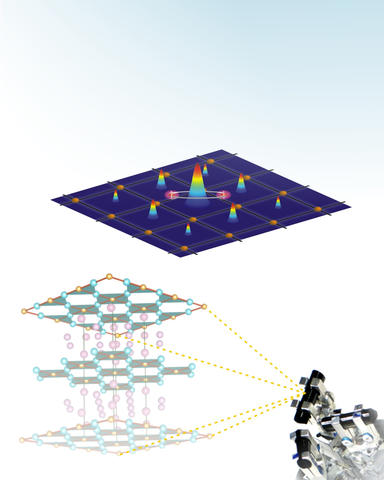
When electrons pair up in alternating layers of copper oxide (checkerboard), superconductivity happens. Researchers found that in materials that superconduct at high temperatures, magnetic excitations (large peak) play a key role in pairing the electrons. The revealing evidence was gathered with neutron probes directed at three carefully aligned crystals of the superconducting material known as PLCCO.
GAITHERSBURG, Md.—When it comes to superconductivity, magnetic excitations may top good vibrations.
Writing in the July 6, 2006, issue of Nature, scientists working at the Commerce Department's National Institute of Standards and Technology (NIST) Center for Neutron Research (NCNR) in collaboration with physicists from the University of Tennessee (UT) and Oak Ridge National Laboratory (ORNL) report strong evidence that magnetic fluctuations are key to a universal mechanism for pairing electrons and enabling resistance-free passage of electric current in high-temperature superconductors.
An important missing piece in the puzzle of high-temperature superconductivity, the finding should boost efforts to develop a variety of useful technologies now considered impractical for conventional superconductors, which work at markedly lower temperatures. Examples include loss-free systems for storing and distributing electric energy, superconducting digital routers for high-speed communications, and more efficient generators and motors.
The team was led by Pengcheng Dai, a UT-ORNL joint professor.
"Our results unify understanding of the role of magnetism in high-temperature superconductivity and move the research community one step closer to understanding the underlying pairing mechanism itself," says NIST physicist Jeffrey Lynn, a member of the collaboration. Better understanding of the mechanism of high-temperature superconductivity may lead to the discovery of new materials in which electrical resistance vanishes at even warmer temperatures.
Objects of intense scientific and technological interest since their discovery in 1986, high-temperature superconductors work their magic in ways different than materials that become superconducting at significantly colder temperatures, as first observed in 1911. In these conventional superconductors, vibrations in the materials' atomic latticework mediate the pairing process that results in the unimpeded flow of electrons.
Scientists have ruled out vibrations, or phonons, as the likely electron matchmaker in high-temperature superconducting compounds. And while they have assembled important clues over the last two decades, researchers have yet to pin down the electron-pairing mechanism in the high-temperature superconductors.
"Various experiments and theories have suggested that this resonance—this sharp magnetic excitation—may be the glue needed to explain high-temperature superconductivity, but key pieces of evidence were missing," explains lead author Stephen Wilson, a UT graduate student.
Previous work by other researchers had determined that magnetism played a role in one of two major classes of high-temperature superconductors—those engineered with holes, or occasional vacancies where electrons normally would reside. But, until this work, carried out at NCNR and ORNL's High Flux Isotope Reactor, the underlying pairing mechanism in the other class—materials doped with an excess of electrons—eluded detection.
Using neutron probes, which are extremely sensitive to magnetism, the team was the first to observe a magnetic resonance in an electron-doped high-temperature superconductor, in a carefully engineered compound known as PLCCO. More importantly, the resonance energy was found to obey a well-established relationship universal to high-temperature superconductors, irrespective of type.
This demonstrated a fundamental link between magnetism and the superconducting phase, the researchers report. These observations and findings should open new avenues of research into the exotic properties of high-temperature superconductors, they write.
NIST, the National Science Foundation and the Department of Energy supported the research.
As a non-regulatory agency of the U.S. Department of Commerce's Technology Administration, NIST promotes U.S. innovation and industrial competitiveness by advancing measurement science, standards, and technology in ways that enhance economic security and improve our quality of life.
NOTE TO EDITORS: The University of Tennessee Office of Communications has issued a complementary news release. Contact Jay Mayfield, (865) 974-9409, jay.mayfield [at] tennessee.edu (jay[dot]mayfield[at]tennessee[dot]edu).
S.D. Wilson, P. Dai, S. Li, S. Chi, H.J. Kang, J.W. Lynn. 2006. Resonance in the electron-doped high-transition-temperature superconductor Pr0.88LaCe0.12CuO4-d . Nature. July 6, 2006

